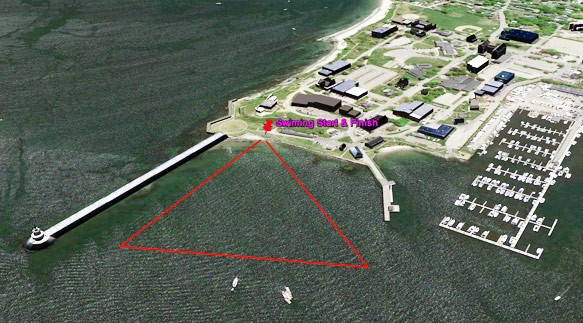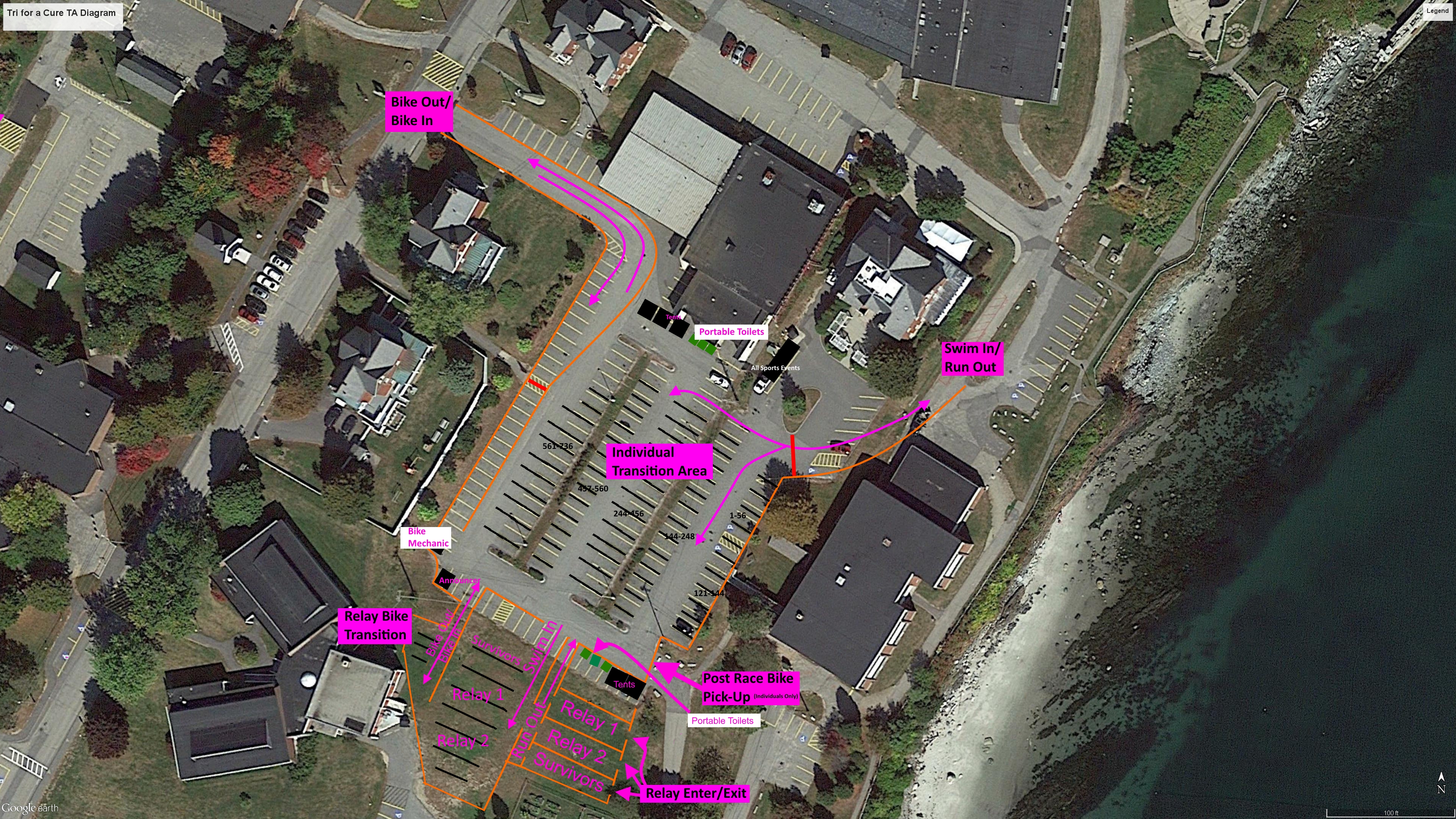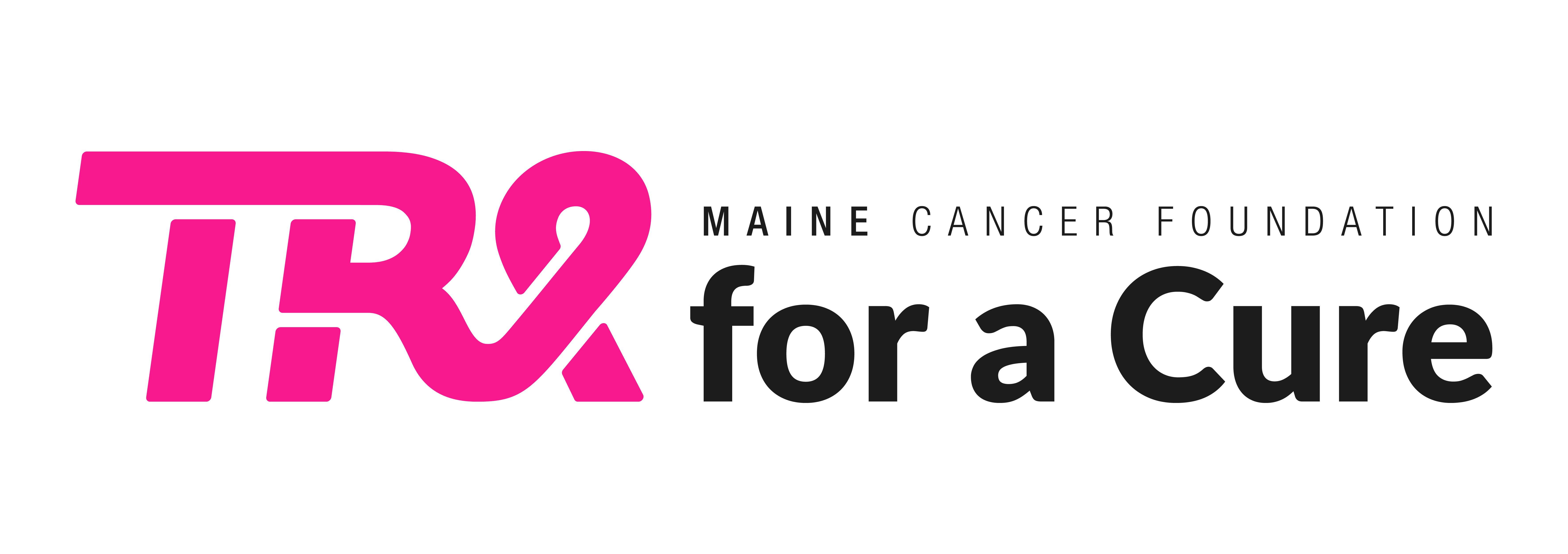
The Tri for a Cure is a major event, and participants need lots of information to have the best experience with training, preparation, and completing the race.
We have put together our Athlete Guide that answers (almost) any questions you may have. Please take the time to read it thoroughly – it will provide invaluable information to have the best possible Tri for a Cure experience.
If you have any questions please email [email protected].
Engage on social media
- Once you're registered, join the 2026 TRI for a Cure Facebook Group.
- Post your fundraising link to your Facebook page - you can link directly from your Donor Drive page so when people donate on Facebook it'll count to your total!
- Put your fundraising link in your Instagram bio so you can refer back to it when posting!
Download the DonorDrive APP
-
Manage and share your Tri for a Cure fundraising on the go with our app for iPhone and Android. Download the DonorDrive App
-
The DonorDrive Charity Fundraising Mobile App allows you to easily update your fundraising story, share with friends and family, and raise money that goes directly to your fundraising page. QR code, yup - now you have one in your pocket!
Review the fundraising levels and deadlines for 2026
- We will determine the Top Fundraiser, the Top 10, the Top TEAM, and earned prizes on Thursday, July 9 at 5:00PM
- To learn more about our fantastic incentive prizes - head over to the FUNDRAISING page.
Get race ready
- Review the event info page
- Swim wave and start time will be posted Summer 2026
Read the Athlete's Guide (Coming this Spring)
Celebrate!
- Kick of the 19th Tri for a Cure - Event details coming soon!
- Mark your calendar for July 11 - the date for an athlete Expo to pick up your incentive prizes.
The 2026 guide will be available Spring 2026
Athlete Schedule:
Expo and Packet Pick-Up: Saturday, July 11, 2025 | 10 AM–2 PM
- Survivor Packet Pick-Up will be located at the Survivor Breakfast starting at 8AM
All athletes must attend to pick up their athlete packet and rack their bike!
Bring your friends and enjoy the fun Expo activities and vendors!
- 10:30am & 12:30pm: Individual Transition Clinic & Triathlon Questions & Answers with Allison Richards in Main Transition Area
- 11:30am & 1:30pm: Relay Team Transition Clinic & Triathlon Questions & Answers with Allison Richards in Relay Transition Area
Tri for a Cure Event: Sunday, July 12, 2026
- 5:30 AM Transition Area Opens in Lot B
- 6:45-7:15 AM Swim Warm up at Spring Point Beach
- 7:15 AM Transition Area Closes
- 7:30 AM Opening Ceremony & Pre-Event Mandatory Meeting at Spring Point Beach
- 8:00 AM Race Begins at Spring Point Beach (Survivor Swim Wave Goes First)
- 11:00 AM Closing Ceremony & Awards
Please make an effort to attend every clinic you register for. Please email [email protected] if you won't be able to attend. Clinic tickets are non-refundable.
2026 Clinics coming soon! Sample listed below:
Clinic Descriptions:
TRI 101
Are you wondering, “Oh my gosh – what did I get myself into?” Well, no need to be asking that question, we are here to put your mind at ease. What do I wear, what equipment do I need, what training is needed, what is race day like? Answers to these and any other questions you may have will be answered. We will have some first-time participants tell you what it was like for them on race day too. You will leave feeling good about the journey you are about to be on!
Limit: Limit 50
Cost: $20
FIRST TIMER SOCIAL
Is this your FIRST TRI for a Cure? Well, WELCOME to the community! Maine Cancer Foundation will host a very casual evening for you to come together with other first timers, MCF staff, and Race Director Allison Richards. This will give you an opportunity to learn more about the organization, ask ANY question you may have, and hopefully find a new training buddy! We will have snacks and beverages – so come for the whole event or stop in to say “hello.”
Limit: Unlimited
Cost: FREE
RIDE THE TFAC BIKE COURSE – 2 Dates this year!
Riding the Tri for a Cure Course is always great training. The better you know the course for race day, the better prepared you are. We will chat quickly to go over the route and safety procedures. Participants will be grouped based on experience. THIS IS A NO DROP RIDE!!! sheJAMs will be there to lead the way! Please only register for one date to allow all who wish to participate a spot!
Limit: 60
Cost: $20
HANDS ON – HOW TO CHANGE YOUR BIKE TIRE
Come learn from the experts on how to change your bike tire. Bring your own bike tire, along with the tools you have to change it with. Bring a bike tube, tire levels, CO2 cartridge. If you don’t have those items, you can buy them at CycleMania before the clinic.
Limit: 30
Cost: FREE
TFAC SWIM CLINICS
There will be four on-course swim clinics held at SMCC. Race Director Allison Richards will discuss water safety, navigation and provide important swimming tips before sending waves of women into the water for a swim around the course. Staff will be available following the swim to answer any questions and concerns. These clinics are offered to provide women the chance to experience an ocean swim with a group, as it will be on race day. This will be a good opportunity to practice with your wetsuit and get comfortable with the cool water temperature. We will have sheJAMs “SWIM ANGELS” available for those who need them.
All participants are encouraged to swim open water with your wetsuit several times before clinics & race day. These clinics should not be your only or first time in open water. Please be prepared, swimming in cold open water for race day takes practice. NO BUOYS WILL BE ALLOWED.
Class Size: 100 per session
Cost: $20
PRE-RACE MEETING
Allison will go over everything you need to know for race day! All this information can be found in the Athlete guide, but this is your opportunity to ask questions and hear about any last-minute changes. This is a great clinic for newbies or for those who have not participated in a few years, or if you just want to be “in the know!”
TRI FOR A CURE TRANSITION CLINICS
Race Director, Allison Richards will present a transition clinic at the TFAC Expo the day before the race. Participants will learn about transition flow, how to set up a transition station, safety and rules of transition. Ample time will be provided for questions. You will not need to sign up for these clinics – just come!
The Tri for a Cure Swim Course
The swim is a 1/3-mile counter-clockwise triangular course that starts and ends on the beach at the beginning of the Spring Point Lighthouse area on the SMCC campus. The cove is fairly well protected from winds and swells. Swimmers are reminded to keep the marking buoys to their left.

Always Safety First
A Coast Guard boat will be in the water, along with several kayak and surfboard lifeguards. Volunteers and medical staff will be stationed on the beach and along the jetty monitoring every moment of the swim. Any athlete in need of assistance during the swim should turn over on their back and wave their hands and someone will come to them. Athletes are permitted to stop and rest on a boat/kayak without any penalty, as long as no forward progress is made.
Note: Any athlete new to ocean swimming or swimming in a wetsuit is STRONGLY ENCOURAGED to practice several times before the race. Several swim clinics are available.
Wet Suits
Due to cold water temperatures (~62 degrees), athletes are STRONGLY ENCOURAGED to wear wetsuits during the swim portion. Although the swim is short in distance, athletes will be in the water for varying amounts of time. Here are some other considerations for protecting body temperature during the swim:
- Neoprene skull cap or second swim cap UNDER Tri for a Cure race cap
- Neoprene booties
- Gloves are not allowed as per USAT triathlon rules
For those prone to hypothermia, please inform medical personnel (in red medical t-shirts) located at the swim start before the race.
Swim Waves
Each swim wave is indicated by a specific swim cap color. Caps will be distributed at packet pickup.
Swim waves will begin promptly at 8:00am, with survivors leading the way. Waves will go off in a time trial system sending two swimmers out every 3-seconds. Wave assignments and specific wave order will be posted at registration. Survivors will go first, followed by Survivor Relay, age groups & relays. Athletes MUST go with their designated swim wave, otherwise, disqualification will result.
After exiting the water onto the beach, run up two steps to Mini-Transition. Athletes will cross over timing mats that will record the end of the swim and the beginning of the first transition time. Remember, the first transition time will include mini transition and your run up to the transition area.
Swim-Transition
In an effort to minimize lost gear, Tri for a Cure has chosen to restrict swim-transition to the bare minimum. A space will be blocked off just off the beach from the swim. This area will be off limits to spectators. Swimmers are requested to bring ONLY their running shoes/sneakers before the swim and place them in the appropriate rack. Signs on the racks will show race number groupings, similar to that in the bike-transition area. As swimmers exit the water and enter into the swim-transition area, they should immediately remove their wetsuits. There are two wetsuit stripping choices to consider:
Assisted Wetsuit Removal:
The swimmer can use the wetsuit strippers to help remove the wetsuit. Upon reaching the wetsuit strippers, athlete should have wetsuit pulled down to waist. The athlete will lie down on her back on the grass and let the wetsuit stripper do the rest. Athlete will be handed her wetsuit and should then proceed to mini transition.
Self-Removal:
Swimmers may also remove their own wetsuit. Please be considerate and make space for other swimmers exiting the water.
After wetsuit removal, each swimmer locates their running shoes previously placed on the numbered racks, puts on her shoes and proceeds to the bike-transition area.
Note: Athletes MUST leave swim-transition carrying wetsuit/swim gear. Tri for a Cure is not responsible for wetsuits left in the swim-transition area. During the 1/4 mile run to the bike-transition area you must wear close-toed shoes - BEST would be to wear sneakers! No flip flops, Crocs or bare feet allowed.
The Tri for a Cure Bike Course
Download a printable version of the Tri for a Cure Race Course Map
Download the Bike Inspection Form
The 15-mile bike route is a lollipop-shaped course on flat and rolling urban roads. The course will be well marked with signs and monitored closely by numerous volunteers wearing orange flags and vests. Please use caution and keep your speed under control, especially when approaching an intersection or turn.
Course Rules:
- Helmets MUST be fastened before getting on your bike! Mounting a bike without YOUR helmet fastened may result in disqualification.
- Helmets may not be unfastened until after passing the dismount line.
- Passing is only allowed on the left.
- Single file riding only.
- Roads are open to automotive traffic and all normal traffic rules are enforced, including stopping traffic lights & stop signs. Be aware!
- Obey all the rules of the road.
- Police may stop cyclists along the course to moderate traffic. The most likely stopping point on course is the Entrance to Portland Headlight.
- iPods or other music players and headphones are not allowed. Disqualification will result.
Course Notes:
- We recommend racking your bike in the lowest (easiest) gear. Fort Road goes uphill immediately after leaving the transition area.
- Use EXTREME caution in two areas:
- Turning LEFT onto Rt. 77 from Sawyer Rd. in Scarborough. A police officer will be stationed at the intersection to help with traffic.
- Turning RIGHT back into the transition area on your return ride. This is a very sharp curve!
- CycleMania will have an official mechanic support station in the transition area and a support vehicle riding along the bike course. Athletes experiencing mechanical difficulties may notify the nearest volunteer so that the mechanic can be alerted. There is no guarantee that the mechanic will be able to fix your bike on the course.
- Three motorcycles will be on the bike course. Riders will be wearing Volunteer t-shirts. They will be looking for distressed cyclists and will come to cyclists’ aid if need be.
- There are no water stations on the bike course. Plan ahead and bring a water bottle!
- Bikes must be re-racked in their original spot before an athlete can proceed to the run!
- Athletes will NOT be allowed back into Transition until the last person has transitioned to the RUN. No exceptions will be made! Keep in mind the waiting time that may result after returning from the run. We suggest keeping a set of clean dry clothes in your car, or with a spectator.
Course Route:
Hints & Tips:
Size Adjustments: Make sure your bike is adjusted to fit your height. Nearly all bikes have adjustable seats and handlebars.
Shorts: Consider wearing triathlon shorts. They have built-in padding for comfort. Tri shorts typically contain less padding than cycle shorts and do not absorb water, so you may prefer them if you are doing all 3 legs of the Tri for a Cure.
Shoes: Bike shoes are recommended. They have stiff soles which give support heel to toe and also can adapt to clipless pedals.
Helmet: Be sure your helmet fits and is within 5 years old. Polystyrene helmets can “dry up” and become brittle with age.
Hydration: Equip your bike with a water bottle rack. It is recommended to drink 1 bottle per hour.
Emergency Flat Kit: Compact bike repair kits can be found at most bike shops and fit easily under the seat.
Traffic: Practice defensive biking! Always assume oncoming traffic hasn't or can't see you.
Bike Maintenance:
Make sure your Bike is safe! Don’t just drag it out of the shed the day before and expect it to work. Local area bike shops can provide bike tune-ups.
There are 3 things you should do on a weekly basis to maintain your bike:
- Check the air in the tires.
- The proper pressure rating can be found on the side of tire. Check your air each time you ride. Low air pressure is the most common flat tire.
- Clean your bike after use.
- Sand and grit from the road will accelerate corrosion and wear.
- Keep the chain lubed up.
- Your bike will pedal faster with less effort!
The Tri for a Cure Running Course
Download a printable version of the running map (PDF)
Note: Headphones and other personal music devices are not allowed on the course. You will be disqualified!
The 3-mile run is a primarily flat loop course utilizing both roads and paved pathways. The course will be clearly marked with signs and monitored closely by volunteers.
There is only one traffic intersection crossing Broadway & Benjamin Pickett. Although this intersection will be monitored by Police, please use caution when crossing.
Turn-by-Turn Directions
- From the starting gate, turn left to McKernan Drive
- Turn right to Fort Road
- Turn left to Osprey
- Follow Osprey – bear left to Slocum (not up hill)
- Quickly bear right to Adams – when you reach the parking lot take a left up Adams.
- At the top of Adams cross the street take right and run on left side of Benjamin Pickett
- Cross Broadway and turn left on Broadway you will run on the sidewalk on the right hand side of Broadway
- Turn right on Preble Ext.
- Turn right on Greenbelt
- Cross to left side of Madison
- Follow Madison to the end of the parking lot staying on the left side of parking lot
- Turn Right to Bug Light Park trail
- Follow Bug Light Park trail all the way around to the exit
- Follow to Madison running on left side of street
- Take Left to Breakwater
- Cross Broadway to Benjamin Pickett
- Take a left to Adams
- Follow Adams to water and take right into Parking Lot F (Osprey)
- Take right through Lighthouse Circle
- Take a left to Bunker Lane
- Follow to path left around the Electronics Building
- Follow pathway until you reach SMCC Cafeteria
- Take right through lot EE
- Take another right to Shoreway Lane
- FINISH!
Water Stations
Water will be available at a station near Transition on Bunker Road and near Mile 1 and Mile 2 on the run course.
Race Number Display
The race number must be displayed on the front at all times during the run portion of the race. This is primarily for safety, but also makes it easier for the Announcer and photographers to recognize athletes crossing the Finish Line.
Clothing
Athletes planning to wear layers should keep in mind that the race number needs to be visible at all times. Do not pin the number to a layer that may be removed. If the race number is left along the course or in Transition, the athlete will need to go back and get it BEFORE finishing the race.
Note: A race belt makes it easy to clip the race number on and off easily. There will be race belts sold at the Expo.

